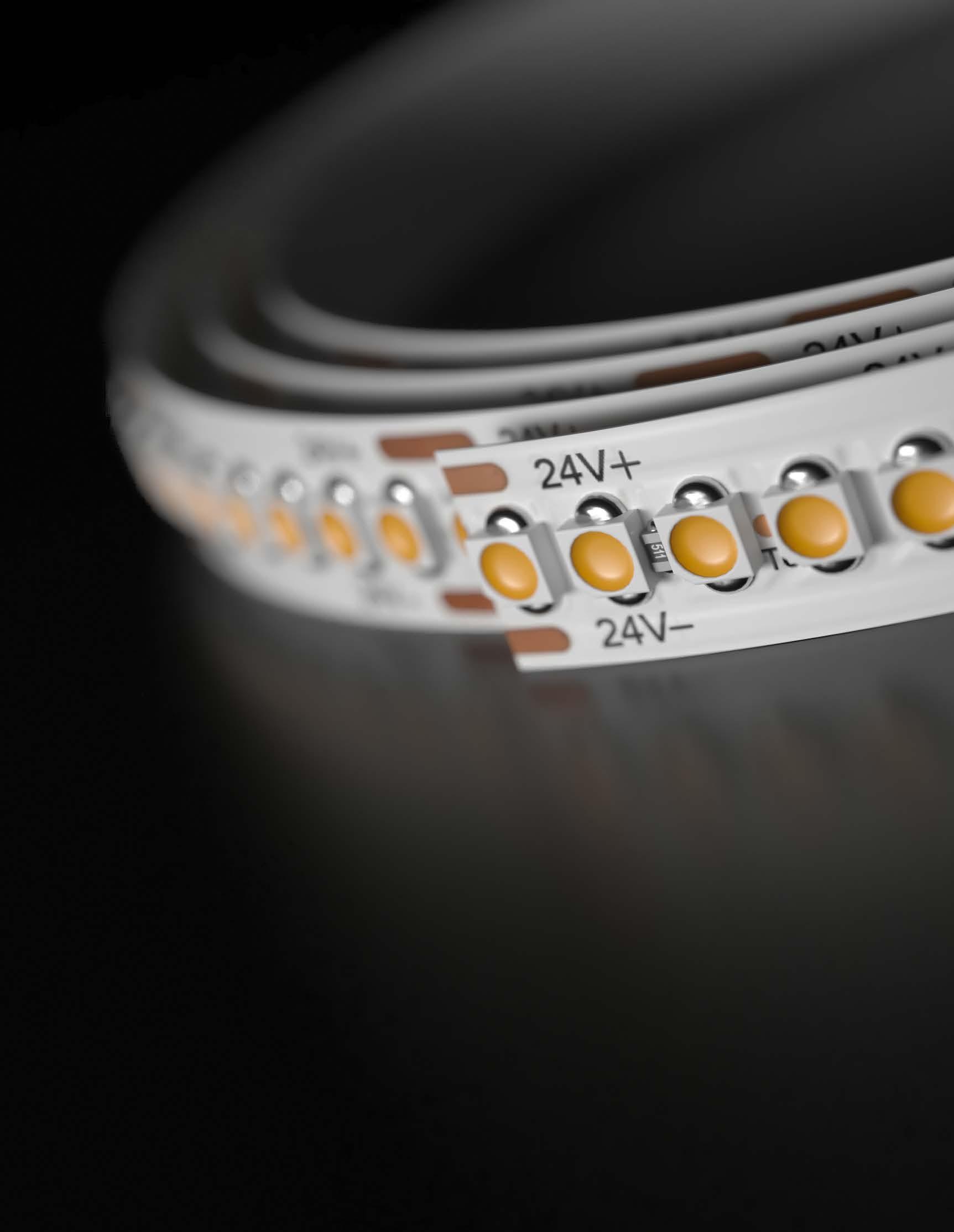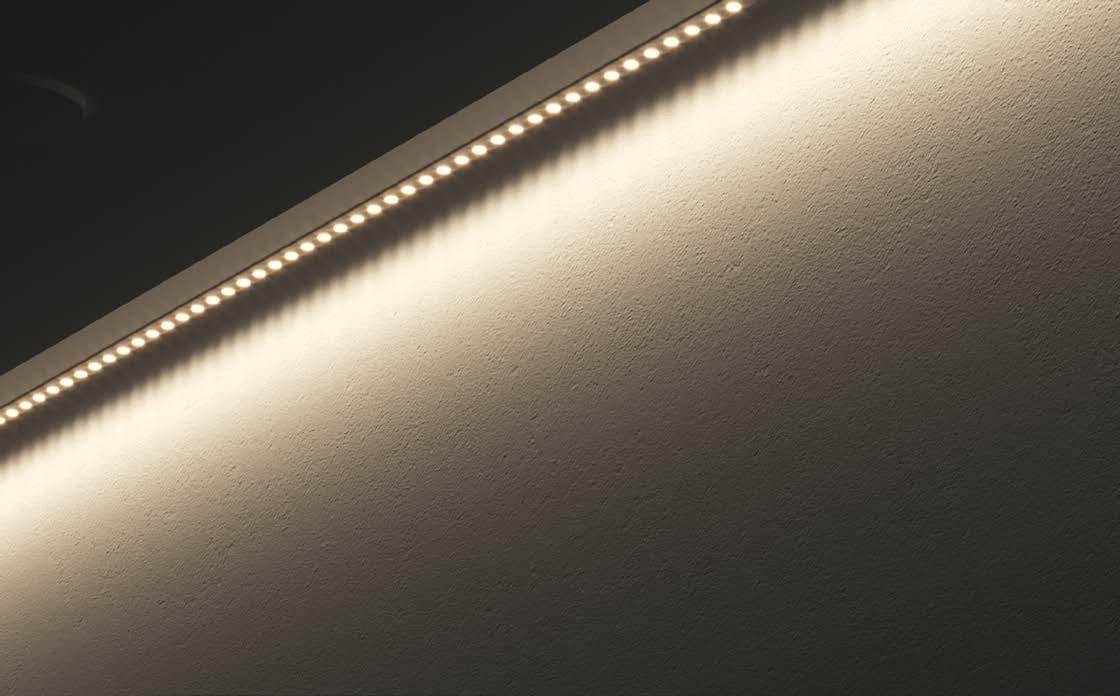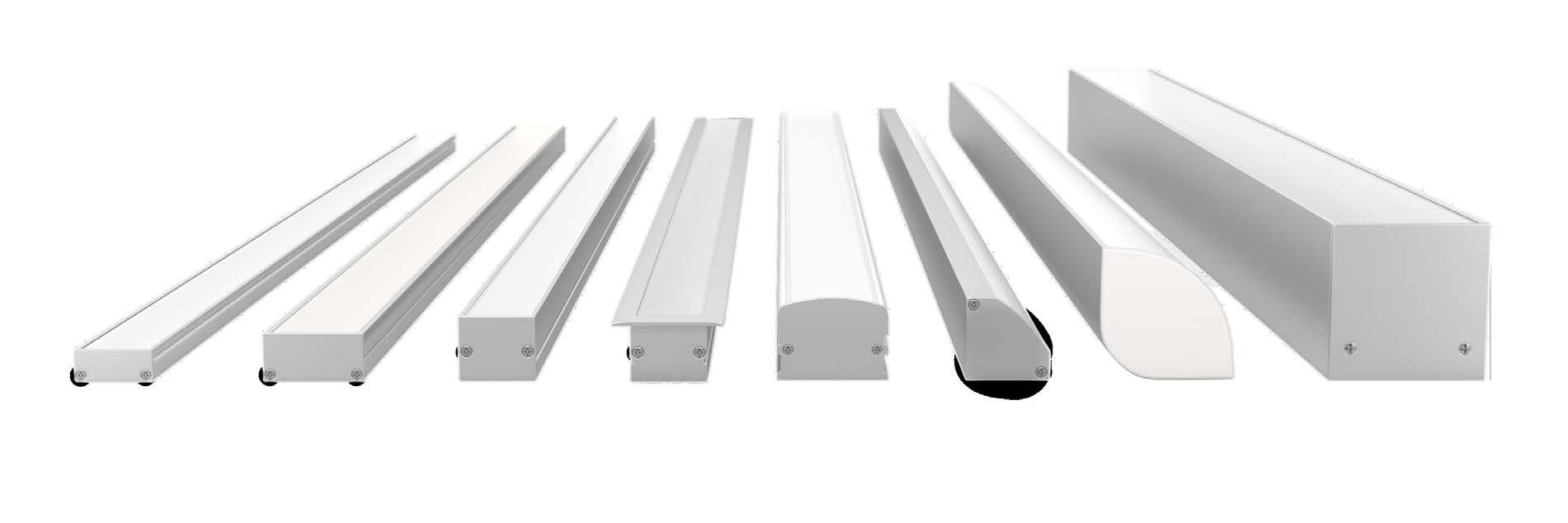

The Luminii LED Story
A Deep Dive into Luminii’s Architecture and Performance

The Luminii LED Story A Deep Dive into Luminii’s Architecture and Performance
Overview
With years of recognition as a leader in architectural linear lighting solutions and product manufacturing, Luminii has built a reputation for delivering best-in-class practices by owning every aspect of the lighting manufacturing process. This starts from our LED design and custom packaging to our phosphor formulation and precise micro binning process. With years of close collaboration with the lighting design community, we heard about how the standard LEDs, designed for general illumination, fail to meet the nuanced needs of designers aiming to enhance human skin tones, enrich interior materials, and create warm, welcoming environments. That’s why we engineer our LED solutions from the ground up, beginning with a narrow-band chip precisely tuned to 452.5–455nm and under-driven for color accuracy and efficiency. Continuing with high-strength PPA brackets, 99.99% gold bond wire, and a C194 copper lead frame with 40μm electroplating, our assembly ensures exceptional thermal performance, long-term reliability, and the true-to-life color fidelity our lighting designers demand.
Our proprietary extrusion and lens designs, combined with in-house engineering and rigorous quality control, allows Luminii to deliver custom-crafted, high-end linear lighting systems that respond to the exacting needs of our customers. Every component is purposly built, every detail is engineered with intent, and every product is proven through performance in the field. The result: lighting solutions that meet the highest standards of design, durability, and visual comfort.
Luminii’s Approach to LED Construction
LED Die and Bracket


LED packaging refers to the process of assembling and protecting the LED die, while optimizing thermal, electrical, and optical performance. A well-designed LED package ensures long-term reliability, consistent light output, and superior color quality. At Luminii, every element of our LED packaging is engineered with precision to meet the demands of high-end architectural lighting. Our custom Narrow-Band LED die is tuned to 452.5–455nm and under-driven for enhanced efficiency and color accuracy while working in perfect sync with our proprietary phosphor blend. A 99.99% gold bond wire ensures superior conductivity and long-term reliability, which far outperforms standard copper alloy alternatives. The high-purity C194 copper lead frame features 40μm silver plating, which is double the industry norm, and gives our LEDs improved conductivity and moisture resistance. Encasing it all, is a rugged PPA (Polyphthalamide) bracket with a thickened wall reflector, delivering mechanical strength and impact resistance during handling and installation.
Phosphor and Encapsulation
While traditional CRI is calculated using only R1–R8 values, Luminii goes further by prioritizing R9. R9 is a key indicator for rendering deep reds and natural skin tones. To go above even that, we follow the TM-30 standard, providing a more comprehensive and accurate evaluation of color quality across the full visible spectrum. Our custom Nitride and GaYAG phosphor blends are optimized for high thermal stability, delivering a high CRI of 95+ and R9 values above 90, which ensures exceptional color fidelity over time. To protect this performance, each LED is encapsulated in optical-grade PDMS (polydimethylsiloxane) silicone, which ensures excellent light transmission, strong environmental sealing, and minimal yellowing and degradation. This ultimately prolongs the life and consistency of the LED.
Lasting Efficiency creating long LED life
Maximizing Color Accuracy
Minimal Degradation

Lighting Color Quality Standards: Technical Overview
ratio phosphor
Accurate and consistent color rendering is essential for evaluating and specifying high-performance lighting systems.
Blackbody Locus (Planckian Locus)
The blackbody curve, or blackbody locus, represents the path that idealized thermal light sources follow in chromaticity space as their temperature changes. It serves as a reference for white light appearance and is used to define CCT. Light sources that lie directly on the curve are considered ideal with balanced spectral output.
CCT (Correlated Color Temperature)
Determined by finding the closest point on the blackbody locus that matches the chromaticity of a given light source. This value corresponds to a theoretical blackbody radiator emitting the same color of light, expressed in Kelvins (K). CCT tells you how warm (yellowish) or cool (bluish) the light appears. It’s based on where the light source would fall along the blackbody curve. For example, a 2700K source looks warm like a traditional incandescent bulb, while 5000K looks like daylight.
Duv (Delta u,v)
Quantifies the perpendicular distance between a light source’s chromaticity point and the blackbody curve in the CIE 1976 (u’,v’) diagram. A Duv of 0.000 means the light is exactly on the blackbody locus. A positive Duv indicates a shift toward green (above the curve), while a negative Duv indicates a shift toward pink or magenta (below the curve). These deviations, even if numerically small, can result in noticeable changes in perceived light quality and affect visual comfort and color consistency
Custom
LED Die
LED Bond Wire
LED Bracket
PCB +
Lead Frame
The Luminii LED Story A Deep Dive into Luminii’s Architecture and Performance

Mastering Color Quality: CRI, R9, and TM-30 in LED Design
CRI (Color Rendering Index)
CRI quantifies how accurately a light source renders colors compared to a reference illuminant (incandescent for <5000K, daylight for >5000K). The metric ranges from 0 to 100, with higher values indicating better color fidelity. The standard CRI calculation (Ra) uses the average of the first 8 test colors (R1–R8), which are desaturated pastel tones. While useful, CRI does not account for saturated or red hues critical in many applications.
R1–R15 (Extended CRI Values)
To address the limitations of Ra, extended CRI values (R1–R15) evaluate a wider range of color samples:
R9 (strong red): Critical for accurate skin tones, medical lighting, and food presentation.
R13/R15: Related to complexion and natural tones. High R9 and extended CRI performance provide a more complete picture of spectral quality.
Standard CRI Rating (R1-R8)

Extended CRI Rating (R9-R15)
TM-30 (IES Method for Evaluating Light Source Color Rendition)
TM-30 is an advanced color rendering metric developed to address the limitations of the traditional CIE CRI standard. Unlike CRI, which relies on a limited set of 8 to 15 pastel color samples, TM-30 evaluates color fidelity using 99 real-world color samples that represent a wide range of hues, saturations, and materials commonly found in everyday environments. This comprehensive approach provides a more accurate and reliable assessment of how light sources render colors. TM-30 also introduces complementary metrics including, Fidelity Index (Rf) and Gamut Index (Rg), to measure both color accuracy and saturation shifts, along with detailed graphical analyses that reveal color distortions and hue shifts. By offering a deeper, more nuanced understanding of color performance, TM-30 enables better-informed lighting design decisions and improved visual experiences across various applications.
Rf (Fidelity Index): Similar to CRI but more robust; indicates how accurately colors are rendered. Rg (Gamut Index): Measures color saturation. Rg > 100 indicates saturation boost; <100 indicates desaturation. TM-30 also provides graphical outputs such as color vector diagrams and hue-angle binning, offering deeper insight into a light source’s spectral performance.
Lighting, Engineered into Every Luminii LED

Halogen lamps are known for their incandescent origin and perfect CRI of 100, and thus have long set the benchmark for natural, warm, and accurate color rendering. Their ability to reveal rich reds and subtle warm tones makes them ideal for creating inviting, human-centric environments. At Luminii, we take pride in replicating the unique visual qualities of halogen lighting through advanced solid-state technology.
Through precise spectral tuning and proprietary phosphor engineering, our LEDs consistently deliver a CRI of 95+ with R9 values above 90, producing vibrant, true-to-life colors across a wide range of applications. But CRI alone doesn’t tell the full story. What matters most is how closely the light spectrum aligns with natural daylight and halogen’s signature warmth—a quality that our LEDs are specifically designed to achieve.
Halogen-Like
The Luminii LED Story A Deep Dive into Luminii’s Architecture and Performance

LED Binning
and Our Micro Binning Process
In LED manufacturing, binning refers to the process of sorting LEDs based on their color (chromaticity) to ensure visual consistency. This is measured using MacAdam Ellipses, which define how close a group of LEDs is to a target color point. A 1-step MacAdam ellipse indicates the tightest tolerance, where color differences are virtually imperceptible to the human eye. 2-step or 3-step binning allows greater variation, which can lead to visible inconsistencies across a fixture or installation.
At Luminii, we implement a precision-driven approach to achieve true 1-step MacAdam Ellipse performance across our linear LED strip lighting. The process begins by sorting LEDs into multiple smaller micro bins based on their chromaticity (x, y) values, creating tighter control than standard binning methods.
Once sorted, the LEDs are strategically placed diagonally across the strip, matching chromaticity values in a way that balances hue and saturation. This technique ensures that the overall color output averages precisely to the target chromaticity point, minimizing visible variation from one end of the strip to the other. Combined with controlled phosphor chemistry and tuned die design, this method delivers consistent color rendering, excellent visual uniformity, and reliable 1-step performance which is ideal for applications where precision and quality of light are critical.


Luminii: Luminii meticulously places each LED on the LED strip using our micro bin processing so that there is color consistency across the entire LED strip, meaning the color at the beginning of the LED strip exactly matches the color at the end of the strip.
Others: Many other lighting manufactuers just randomly take and place LEDs on their LED strip. While directly comparing two LEDs together, you may not notice a color difference, if you stack many LEDs from the same side of a MacAdams ellipse together on the LED strip, you may notice a slight color striations across the whole LED strip.
Building Beyond the Engine: PCB, Lens, and Extrusion Design at Luminii
A high-performance engine is only as strong as the systems around it. That’s why at Luminii, we don’t just engineer great LEDs, we build a full ecosystem around them: high-performance PCBs, precision optics, and architectural-grade extrusions.
Precision PCBs: The Foundation of Light Consistency
Luminii’s linear LED strips are engineered for high performance and reliability through a combination of dual-layer PCB design and robust material selection. Each board uses 3–4 oz. copper with optimized front and back trace geometry to improve thermal dissipation, minimize voltage drop, and maintain consistent lumen output. Solder pads support 18AWG wire and are compatible with Luminii minii con nectors for durable, field-friendly connections. The strip uses 3M VHB thermally conductive adhesive for secure bonding and efficient heat transfer, and it is mechanically reinforced to resist pulling and twisting during installation.consistency.

Luminii via Micro Bin Process Others via Standard Bin Process
The Luminii LED Story A Deep Dive into Luminii’s Architecture and Performance

Optical Lens Design: Engineered for Clarity and Color Fidelity
Luminii’s lenses are designed in-house for linear LED applications, using optical-grade, UV-stabilized polymers tested for over 1,000 hours under UV, heat, and humidity to prevent yellowing, warping, or degradation. Each lens incorporates custom-engineered diffusing materials and a uniform matte surface finish, eliminating glare from reflective surfaces while optimizing Light Down Ratios (LDRs). This ensures dot-free illumination, precise beam control, and high optical efficiency, all while preserving the LED’s original CCT and CRI for true-to-spec color rendering and clean architectural presentation.





Extrusion Design: Form, Function, and Finish
Luminii extrusions are made from 6063-T5 architectural-grade aluminum and engineered in-house for superior rigidity, exceptional thermal management, and optical alignment. With a 0.035” minimum wall thickness, each profile provides robust structural support and effective heat dissipation making them ideal for long continuous runs and high-output applications. In addition, the added rigidity proves invaluable during the installation since our long extrusions maintain structural integrity when handled from one end.
Every profile undergoes thermal and optical simulation to ensure efficient cooling and light performance. Designed for clean integration, extrusions feature concealed mounting, finish matching mounting, flush endcaps and invisible hardware for a refined architectural look.
Proudly USA Made, and available in lengths up to 12 feet with broadest finish spectrum in the industry. Luminii extrusions provide both technical precision and visual impact in any application.


Optimal thermal heat dissipation Poor thermal heat dissipation


Exceptional rigidity Flimsy off-the-shelf design
Concealed Mounting
Seamless Endcaps
Invisible Hardware
Lens Color Consistency
Mismatched Endcaps
Lens Color Inconsistency
Luminii
Exceptional rigidity Flimsy off-the-shelf design
Luminii
Others (2700K)
Luminii 2700K
on
LED strip Lens on
LED strip


